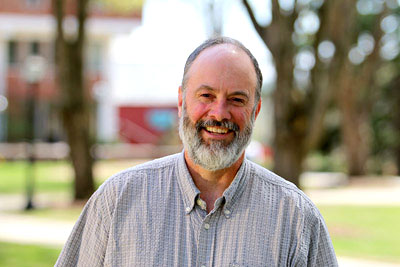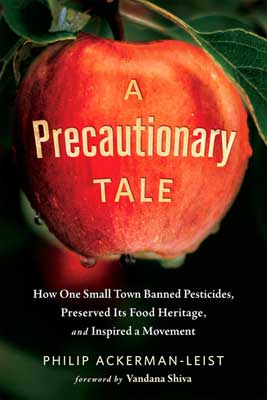 |
| At the 2018 Maine Agricultural Trades Show, Philip Ackerman-Leist spoke about Mals, Italy, which banned synthetic pesticides. Photo courtesy of Chelsea Green |
Philip Ackerman-Leist Speaks in Maine
By Stowell P. Watters
There is a place in Northern Italy, right at the top of the boot, where farmers who raise fruits and vegetables, grain and hay, goats, cows, pigs and sheep, and those who make cheese, cure meat and bake ancient rye breads have, for 30 generations, thrived amid the howling winds, deep snows and steep pitch of the mountainside. This place is called Mals, in the province of South Tirol in the geographical area known as the Upper Vinschgau Valley, about 3,500 feet up in the Alps. Here you can taste exquisite organic food, stay the night in a castle, or even see Ötzi, the Ice Man, the oldest mummy in Europe. Or, if you want, you can go to Mals to see where farmers, gardeners, cooks, bakers and common citizens drew a line in the crust of the Earth, said no to synthetic pesticides, beat back the billion-dollar conventional apple industry, and shocked the world with the power of direct democracy.
Philip Ackerman-Leist wrote the story of the miracle in Mals in his book “A Precautionary Tale” after living and farming near Mals for four years. This winter he spoke at the Maine Federation of Farmers’ Markets (MFFM) annual Market Convention at the Maine Agricultural Trades Show in Augusta. Ackerman-Leist stepped up to the podium that day in the midst of his national book tour to talk about food systems, farmers’ markets and the reverberating implications of the events that transpired below the glacial peaks in Italy.
“I believe we are at the fulcrum of opportunity for tipping the scales in our favor, and so the name of this talk is ‘Hacking the Local Foodshed: Why Farmers’ Markets Matter More than Ever,’” he said.
Ackerman-Leist is a veritable Venn diagram: one part farmer, one part teacher and one part author, each sphere of his life intersecting close enough as to blur together to form one solid hue. He started the organic farm where he teaches at Green Mountain College in Vermont, as well as the undergraduate curriculum and masters programs for sustainable agriculture and food systems. At his home in eastern Vermont, he and his wife raise grass-fed beef cattle. In his spare time he has written three books: “Up Tunket Road: The Education of a Modern Homesteader,” “Rebuilding the Foodshed,” and his most recent, about the people of Mals and their struggle against the Big Apple industry.
At the MFFM conference he focused on the power of people to change the food system through farmers’ markets. With more than 100 summer farmers’ markets in Maine, from Kittery to Madawaska, and more than 30 winter markets, his message felt particularly poignant for our state.
“Farming can be a lonely endeavor,” said Ackerman-Leist, “and the market is a place where farmers can celebrate one another. Our culture is divorced from agriculture, but the farmers’ market is a place where agricultural literacy happens, where farmers have an opportunity to change the game.”
By agricultural literacy he means the direct interaction between people and farmers and their food, and the deeper understanding of how they are connected and how they function. Without agricultural literacy, Ackerman-Leist said, we end up with an economy where cash “vaporizes into the pockets of millionaires.”
According to Ackerman-Leist, farmers’ markets are where farmers can get the highest percentage of consumers’ dollars back in their pockets, as opposed to about 18 cents on the dollar for most wholesale markets, according to the USDA Economic Research Service. Additionally farmers’ markets are a place where the public can interact and create community, through regular old chit chat as well as educational programs in cooking and nutrition sponsored by the markets themselves. Many markets, particularly in Maine, offer SNAP (Supplemental Nutrition Assistance Program) benefits as well as post-market gleaning – both of which can get healthy food to those who need it most and which help refute the notion that local food is impossibly expensive.
He also spoke about the democracy inherent in farmers’ markets and how they seem to defy most other cultural hubs or gathering places because of their ability to attract people of every political persuasion and socioeconomic standing. What’s more, he posited, is that farmers’ markets serve as an example of a free market where both consumer and producer have direct control of their destiny.
 |
| Ackerman-Leist’s book “A Precautionary Tale” tells about the conventional apple industry that threatened Mals, Italy, and the response of the community to that threat. |
This is where the story of Mals, Italy, is enlightening. Long considered the breadbasket of the Tirol region, the Upper Valley flourished for centuries using ancestral agricultural and culinary methods – as, for example, with the Palabirne, a small, round pear sliced thin, dried on a string and used as a sweetener in lieu of sugar. Spelt is another example. A husband and wife found spelt wrapped in a newspaper from the 1800s and brought back the crop, which is now grown all over the hillsides. Likewise, a particularly hardy rye grows there, and a pair of brothers and local bakers say it is more alive and wonderful than any they can import.
Then, of course, there is Ötzi, the mummy who was found in the melting glacier above the villages, from the Copper Age. On him grew a rare moss found only in the Vinschgau Valley. On his clothes and in his gut were grains of flax, poppy seed, emmer, einkorn, spelt, hulled barley and broomcorn millet. Bread made from these ancient grains remains a staple of the South Tirolean diet to this day.
“He is the embodiment of agriculture, nutrition, and land management in the millennia preceding the Age of Big Apple,” Ackerman-Leist writes in his book.
While the people of Mals were busy channeling the ancient ways of their ancestors, big change was coming to the lower valley – an area particularly well suited for cultivating the dwarf apple. Cement posts with high tensile wire and acres of manicured trees crept up, closer and closer to the region, but what worried the citizens of Mals most was the drift of pesticide spray, which they were able to prove time and time again was landing on and incorporated into their farms, fields and even schoolyards.
Apple growers may spray up to 30 different pesticides about 12 to 14 times a year, throughout the tree canopy. Drift is inevitable. For the people of Mals, preserving their way of life meant fighting the advance of a chemical industry that sees profits of more than $50 billion a year. And fight they did.
The town, led by a cast of creative and artistic men and women and an enigmatic mayor, formed the Advocacy Committee for a Pesticide-Free Mals and eventually used expert opinions, debate, artwork, food and sheer luck to pass an initiative barring the use of synthetic pesticides in their Upper Valley paradise. Also part of the legislation was a push to become a fully organic locale, with schools and public buildings serving organic food, and farms transitioning to organic with financial support. Their triumph was the first of its kind.
Maine is one of the few states where the spirit of Ackerman-Leist’s book seems to be taking hold. Earlier this year the City Council of Portland voted unanimously in favor of an ordinance regulating pesticide use in Maine’s largest city. The strong ordinance bars city workers from spraying synthetic pesticides within city limits (with a few exceptions) and comes with funds for a campaign to educate the public about ways to maintain their lawns without using synthetic chemicals.
All but seven states have a law that preempts communities from enacting ordinances that regulate pesticide use. Along with Maine, only Alaska, Hawaii, Utah, Nevada, Maryland and Vermont still permit communities to manage pesticide use.
Ackerman-Leist hopes that more communities can participate in this form of direct democracy. His book includes resources for the fight against synthetic pesticide use and big ag lobbying money. Pushing back on pesticides at home starts with providing factual and objective information about the health risks of pesticide use to enable citizens to begin their campaign.
From the farmers’ markets in Maine to the chilly alm high pastures of Mals, Italy, agricultural literacy is taking hold. Communities are taking their destiny and their health into their own hands and fighting to keep their precious dollars and food local.
Ackerman-Leist provided the following resources:
Pesticide Action Network
https://www.panna.org and https://www.pan-europe.info
Beyond Pesticides
https://www.beyondpesticides.org
Consumers Union
https://consumersunion.org/topic/food
Environmental Working Group
https://www.ewg.org
Food and Water Watch
https://www.foodandwaterwatch.org
Union of Concerned Scientists
https://www.ucsusa.org/food_and_agriculture#.vyjexd-hqqy
Natural Resources Defense Council
https://www.nrdc.org/issues/food
About the author: Stowell P. Watters, a former MOFGA journeyperson, runs MOFGA-certified organic Old Wells Farm with his family in Limington, Maine.
